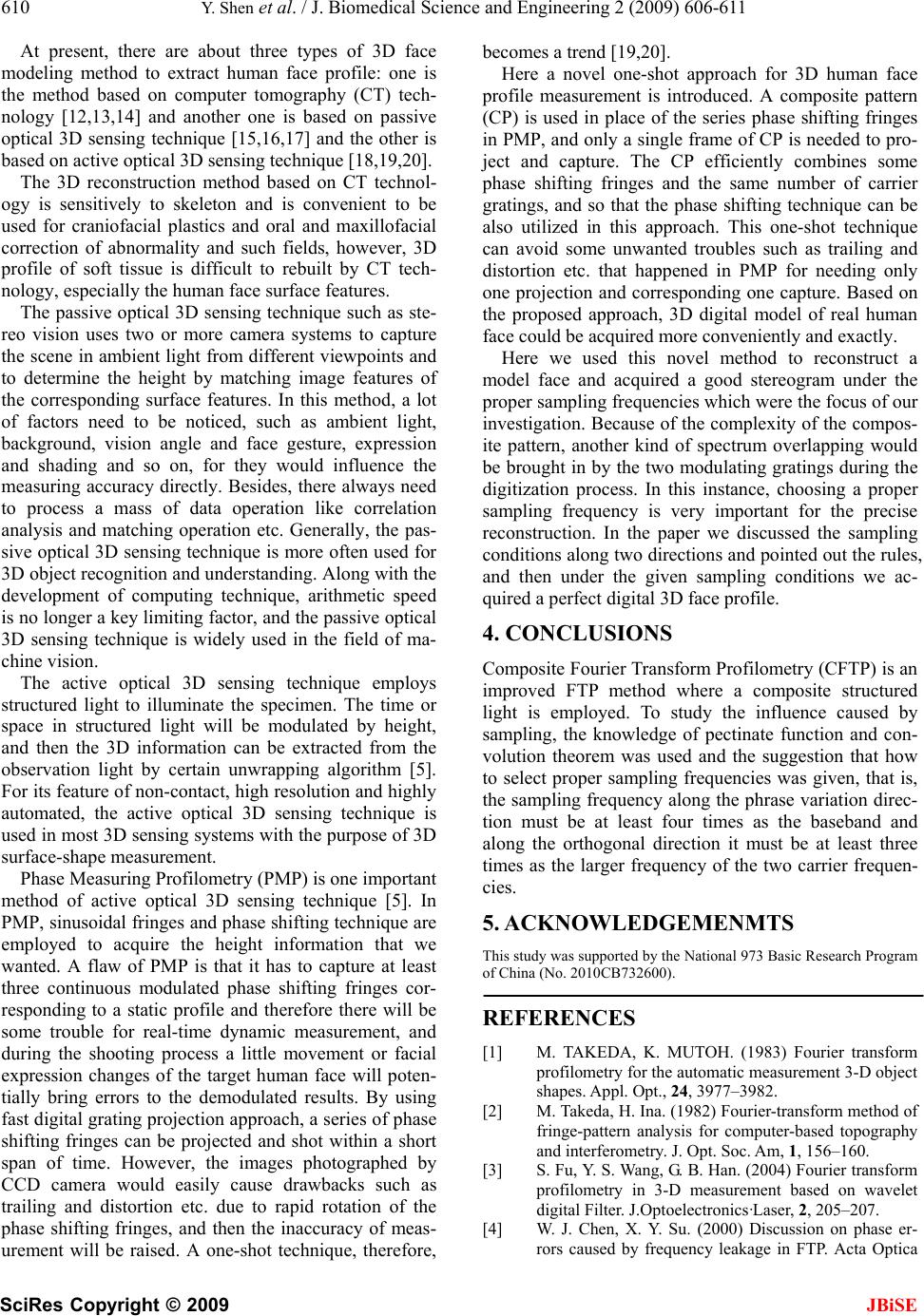
610 Y. Shen et al. / J. Biomedical Science and Engineering 2 (2009) 606-611
SciRes Copyright © 2009 JBiSE
At present, there are about three types of 3D face
modeling method to extract human face profile: one is
the method based on computer tomography (CT) tech-
nology [12,13,14] and another one is based on passive
optical 3D sensing technique [15,16,17] and the other is
based on active optical 3D sensing technique [18,19,20].
The 3D reconstruction method based on CT technol-
ogy is sensitively to skeleton and is convenient to be
used for craniofacial plastics and oral and maxillofacial
correction of abnormality and such fields, however, 3D
profile of soft tissue is difficult to rebuilt by CT tech-
nology, especially the human face surface features.
The passive optical 3D sensing technique such as ste-
reo vision uses two or more camera systems to capture
the scene in ambient light from different viewpoints and
to determine the height by matching image features of
the corresponding surface features. In this method, a lot
of factors need to be noticed, such as ambient light,
background, vision angle and face gesture, expression
and shading and so on, for they would influence the
measuring accuracy directly. Besides, there always need
to process a mass of data operation like correlation
analysis and matching operation etc. Generally, the pas-
sive optical 3D sensing technique is more often used for
3D object recognition and understan ding. Alo ng with the
development of computing technique, arithmetic speed
is no longer a key limiting factor, and the passive optical
3D sensing technique is widely used in the field of ma-
chine vision.
The active optical 3D sensing technique employs
structured light to illuminate the specimen. The time or
space in structured light will be modulated by height,
and then the 3D information can be extracted from the
observation light by certain unwrapping algorithm [5].
For its feature of non-contact, high resolution and highly
automated, the active optical 3D sensing technique is
used in most 3D sensing systems with the purpose of 3D
surface-shape measurement.
Phase Measuring Profilometry (PMP) is one i mportant
method of active optical 3D sensing technique [5]. In
PMP, sinusoidal fringes and phase shifting technique are
employed to acquire the height information that we
wanted. A flaw of PMP is that it has to capture at least
three continuous modulated phase shifting fringes cor-
responding to a static profile and therefore there will be
some trouble for real-time dynamic measurement, and
during the shooting process a little movement or facial
expression changes of the target human face will poten-
tially bring errors to the demodulated results. By using
fast digital grating projection approach, a series of phase
shifting fringes can be projected and shot within a short
span of time. However, the images photographed by
CCD camera would easily cause drawbacks such as
trailing and distortion etc. due to rapid rotation of the
phase shifting fringes, and then the inaccuracy of meas-
urement will be raised. A one-shot technique, therefore,
becomes a trend [19,20].
Here a novel one-shot approach for 3D human face
profile measurement is introduced. A composite pattern
(CP) is used in place of the series phase shifting fringes
in PMP, and only a single frame of CP is needed to pro-
ject and capture. The CP efficiently combines some
phase shifting fringes and the same number of carrier
gratings, and so that the phase shifting technique can be
also utilized in this approach. This one-shot technique
can avoid some unwanted troubles such as trailing and
distortion etc. that happened in PMP for needing only
one projection and corresponding one capture. Based on
the proposed approach, 3D digital model of real human
face could be acquired more conveniently and exactly.
Here we used this novel method to reconstruct a
model face and acquired a good stereogram under the
proper sampling frequencies which were the focus of our
investigation. Because of the comp lexity of the compos-
ite pattern, another kind of spectrum overlapping would
be brought in by the two modulating gratings during the
digitization process. In this instance, choosing a proper
sampling frequency is very important for the precise
reconstruction. In the paper we discussed the sampling
conditions along two directions and pointed ou t the rules,
and then under the given sampling conditions we ac-
quired a perfect digital 3D face profile.
4. CONCLUSIONS
Composite Fourier Transform Profilometry (CFTP) is an
improved FTP method where a composite structured
light is employed. To study the influence caused by
sampling, the knowledge of pectinate function and con-
volution theorem was used and the suggestion that how
to select proper sampling frequencies was given, that is,
the sampling frequency along the phr ase variation direc-
tion must be at least four times as the baseband and
along the orthogonal direction it must be at least three
times as the larger frequency of the two carrier frequen-
cies.
5. ACKNOWLEDGEMENMTS
This study was supported by the National 973 Basic Research Program
of China (No. 2010C B7 32600).
REFERENCES
[1] M. TAKEDA, K. MUTOH. (1983) Fourier transform
profilometry for the automatic measurement 3-D object
shapes. Appl . Opt., 24, 3977–3982.
[2] M. Takeda, H. Ina. (1982) Fourier-transform method of
fringe-pattern analysis for computer-based topography
and interferometry. J. Opt. Soc. Am, 1, 156–160.
[3] S. Fu, Y. S. Wang, G. B. Han. (2004) Fourier transform
profilometry in 3-D measurement based on wavelet
digital Filter. J.Optoelectronics·Laser, 2, 205–207.
[4] W. J. Chen, X. Y. Su. (2000) Discussion on phase er-
rors caused by frequency leakage in FTP. Acta Optica